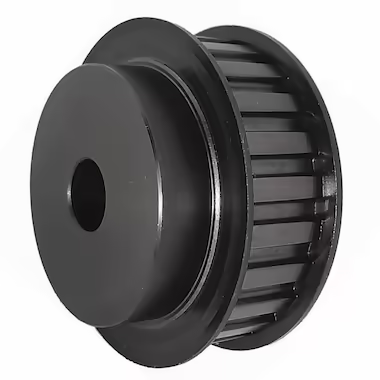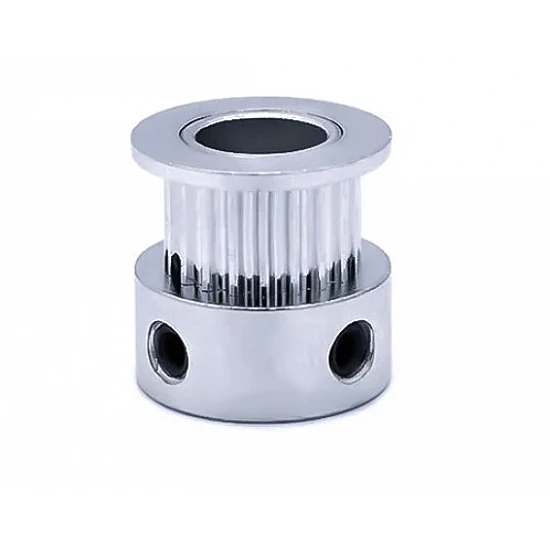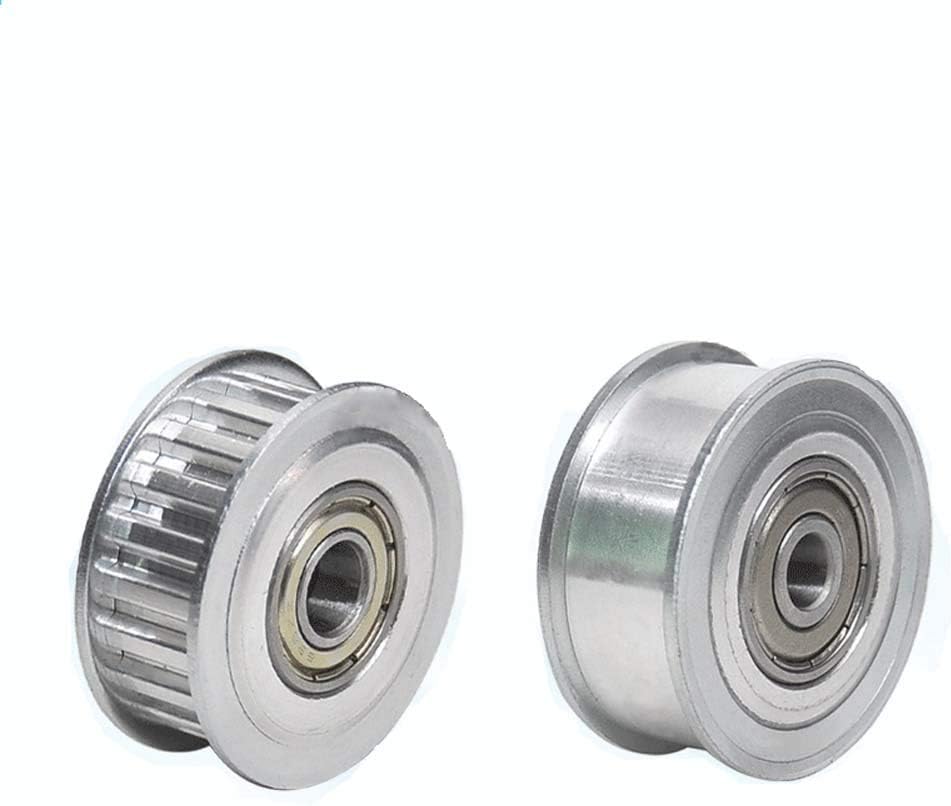Product Description
Mxl XL L S2m S3m S5m 3m 5m Htd3m Htd5m 2gt 5gt Timing Pulley With Set Screw Hole
Rely on the driving wheel to push the driven wheel in turn to transmit the movement and power between the 2 shafts. Due to the characteristics of wheels
1. Mesh transmission, accurate transmission ratio, stable transmission and low noise.
2. Wide range of power and speed.
3. High efficiency, long service life, safe and reliable work.
4. The cost is not very high, and special equipment is required for processing.
Product Parameters
| Product | standard timing belt pulley & idler pulley |
| Customized | OEM, drawings or samples customized |
| Teeth type | Normal Torque Drive Type:MXL,XL,L,H,XH,XXH High Torque Drive Type:S2M,S3M,S5M,S8M,HTD2M,HTD3M,HTD5M,HTD8M,P2M,P3M,P5M,P8M High Precision Position Drive Type:2GT,3GT,5GT,8YU Light Load Drive Type:T5,T10,T20 Heavy Load Drive Type:AT5,AT10,AT20 |
| Basic shape | Type A,Type B,Type D,Type E,Type F,Type K |
| Adaption | Adapt to 1/4 inch,5/16 inch,1/2 inch, 3/8inch, 2/25inch, 1/5inch belt |
| surface treatment | Natural color anodizing,Black anodizing,Hard anodizing,Ni-plating,Blackening |
| Material | 6061(aluminum),S45C(45# steel),SUS304(Stainless steel) |
| Bore | Pilot bore, Taper bore and Customized bore. |
| Tolerance Control | Outer diameter ±0.005mm Length dimension ±0.05mm |
| Standard | DIN, ISO/GB, AGMA, JIS |
| Teeth Accuracy | DIN Class 4, ISO/GB Classs 4, AGMA Class 13, JIS Class 0 |
| Weight | Max 15Tons |
| testing equipment | projecting apparatus,salt spray test,durometer,and coating thickness tester,2D projector |
| producing equipment | CNC machine,automatic lathe machine,stamping machine,CNC milling machine,rolling machine,lasering,tag grinding machine etc. |
| Machining Process | Gear Hobbing, Gear Milling, Gear Shaping, Gear Broaching,Gear Shaving, Gear Grinding and Gear Lapping |
| Application industry | Robot industry,Medical industry,Making machine industry,Automation industry,3C industry equipment,Packaging industry,UAV industry,New energy industry. |
Company Profile
Packaging & Shipping
| lead time | 10-15 working days as usual,30days in busy season,it will based on the detailed order quantity |
| Delivery of samples | by DHL,Fedex,UPS,TNT,EMS |
FAQ
| Main markets | Southeast Asia, North America, Eastern Europe, Mid-East, West Europe |
| How to order | *You send us drawing or sample |
| *We carry through project assessment | |
| *We give you our design for your confirmation | |
| *We make the sample and send it to you after you confirmed our design | |
| *You confirm the sample then place an order and pay us 30% deposit | |
| *We start producing | |
| *When the goods is done,you pay us the balance after you confirmed pictures or tracking numbers | |
| *Trade is done,thank you! |
| Certification: | CE, ISO |
|---|---|
| Pulley Sizes: | Type A |
| Manufacturing Process: | Forging |
| Material: | Alloy |
| Surface Treatment: | Oxygenation |
| Application: | Chemical Industry, Grain Transport, Mining Transport, Power Plant, Machinery Parts |
| Samples: |
US$ 10/Piece
1 Piece(Min.Order) | |
|---|
| Customization: |
Available
| Customized Request |
|---|

How do XL pulleys compare to other pulley types, such as HTD or V-belt pulleys?
XL pulleys, HTD pulleys, and V-belt pulleys are all popular types of pulleys used in mechanical systems. Here is a detailed comparison of XL pulleys with HTD and V-belt pulleys:
1. Tooth Profile:
XL pulleys and HTD (High Torque Drive) pulleys both utilize toothed belts for power transmission. The main difference lies in their tooth profiles. XL pulleys have trapezoidal teeth, while HTD pulleys have a curvilinear tooth profile. V-belt pulleys, on the other hand, are designed for V-belts, which have a wider, wedge-shaped cross-section.
2. Power Transmission Capacity:
XL pulleys and HTD pulleys offer higher power transmission capacities compared to V-belt pulleys. The toothed belt designs of XL and HTD pulleys provide a positive engagement, preventing slippage under higher loads or torque. V-belt pulleys rely on friction between the belt and pulley, limiting their power transmission capacity.
3. Speed Capability:
XL pulleys and HTD pulleys are both suitable for higher speed applications compared to V-belt pulleys. The toothed belt designs allow for better grip and reduced belt slippage, enabling XL and HTD pulleys to operate at higher rotational speeds without compromising performance. V-belt pulleys are generally suitable for lower speed applications.
4. Efficiency:
XL pulleys and HTD pulleys offer higher efficiency compared to V-belt pulleys. The positive engagement between the toothed belts and pulleys in XL and HTD systems minimizes slippage and associated energy losses. V-belt pulleys, relying on friction, may experience higher energy losses due to belt slip.
5. Precision and Positioning:
XL pulleys and HTD pulleys provide better positional accuracy and reduced backlash compared to V-belt pulleys. The toothed belt systems offer improved control and synchronization, making them suitable for applications that require precise positioning or timing, such as robotics or CNC machines.
6. Noise and Vibration:
XL pulleys and HTD pulleys generally produce less noise and vibration compared to V-belt pulleys. The toothed belt systems exhibit smoother operation due to their positive engagement, reducing noise and vibration levels. V-belt pulleys may generate more noise and vibration due to potential slippage and belt oscillation.
7. Installation and Maintenance:
XL pulleys, HTD pulleys, and V-belt pulleys are all relatively easy to install and maintain. However, V-belt pulleys may require more frequent tension adjustments and periodic belt replacements due to belt wear and stretch. Toothed belt systems, including XL and HTD pulleys, often require less maintenance and offer longer belt life.
8. Application Suitability:
The choice between XL pulleys, HTD pulleys, and V-belt pulleys depends on the specific application requirements. XL and HTD pulleys are commonly used in industrial automation, power transmission, and precision machinery applications that demand higher torque, speed, and accuracy. V-belt pulleys are often employed in applications such as HVAC systems, automotive engines, and smaller machinery.
In summary, XL pulleys, HTD pulleys, and V-belt pulleys have differences in tooth profile, power transmission capacity, speed capability, efficiency, precision, noise/vibration levels, installation/maintenance, and application suitability. Understanding these differences is crucial in selecting the most appropriate pulley type for a given mechanical system and its specific requirements.

How does the tooth profile of XL pulleys contribute to their performance?
The tooth profile of XL pulleys plays a crucial role in determining their performance in power transmission systems. Here’s a detailed explanation of how the tooth profile contributes to their performance:
1. Efficient Power Transmission:
The tooth profile of XL pulleys is designed to engage with the corresponding teeth on the timing belt. This positive engagement ensures efficient power transmission by minimizing slippage and maximizing the transfer of rotational motion. The tooth profile allows for a large contact area between the pulley and the belt, enabling effective torque transfer and minimizing energy losses.
2. Accurate and Repeatable Positioning:
The tooth profile of XL pulleys enables accurate and repeatable positioning in motion control systems. The teeth on the pulley mesh precisely with the teeth on the timing belt, providing precise angular displacement and positioning control. This tooth engagement allows for reliable and consistent positioning, making XL pulleys suitable for applications that require high positional accuracy, such as robotics and CNC machines.
3. Reduced Backlash:
The tooth profile of XL pulleys helps reduce backlash, which is the play or clearance between the teeth of the pulley and the belt. Backlash can introduce inaccuracies and vibrations in the power transmission system. The tooth profile of XL pulleys minimizes backlash by ensuring a close fit with the timing belt teeth, resulting in smoother operation, improved precision, and reduced mechanical vibrations.
4. Load Distribution:
The tooth profile of XL pulleys allows for effective load distribution along the width of the belt. As torque is transmitted from the pulley to the belt, the tooth profile ensures that the load is evenly distributed across the belt’s width. This load distribution helps prevent concentrated stress points and excessive wear on specific areas, leading to improved durability and longevity of the pulley and belt.
5. Noise Reduction:
XL pulleys with well-designed tooth profiles contribute to reduced noise levels during operation. The tooth engagement and smooth meshing between the pulley and the timing belt minimize vibration and noise generation. This advantage is particularly important in applications that require low noise levels, such as medical equipment, office machinery, and audiovisual systems.
Overall, the tooth profile of XL pulleys significantly impacts their performance by enabling efficient power transmission, precise positioning, reduced backlash, even load distribution, and noise reduction. Manufacturers carefully design the tooth profiles of XL pulleys to optimize these performance characteristics for various applications and operating conditions.

What materials are typically used in the construction of XL pulleys?
The construction of XL pulleys involves the use of various materials, depending on the specific application requirements, load capacity, and cost considerations. Here are the materials commonly used in the construction of XL pulleys:
1. Aluminum:
Aluminum is a lightweight and corrosion-resistant material commonly used in XL pulleys. It offers good strength-to-weight ratio and excellent machinability, making it suitable for many applications. Aluminum pulleys are often used in robotics, automation systems, and other applications where weight reduction is desirable.
2. Steel:
Steel is a durable and robust material used in XL pulleys for applications that require higher load capacity and strength. Steel pulleys provide excellent resistance to wear and can handle heavy-duty applications. They are commonly used in industrial machinery, automotive components, and other demanding applications.
3. Plastic:
Plastic pulleys are lightweight, cost-effective, and offer good resistance to chemicals and corrosion. They are commonly made from materials such as nylon, acetal, or polycarbonate. Plastic pulleys are used in a variety of applications, including 3D printers, medical devices, and smaller-scale machinery.
4. Composite Materials:
Composite materials, such as fiberglass-reinforced polymers, are sometimes used in the construction of XL pulleys. These materials offer a combination of properties, including high strength, low weight, and resistance to corrosion. Composite pulleys are often used in aerospace, marine, and other specialized applications.
5. Stainless Steel:
Stainless steel is chosen for XL pulleys when corrosion resistance is of utmost importance. Stainless steel pulleys exhibit excellent resistance to rust and corrosion, making them suitable for applications in harsh environments or where exposure to moisture or chemicals is expected.
It’s important to note that the material selection for XL pulleys depends on factors such as the application requirements, load capacity, environmental conditions, and budget constraints. Manufacturers consider these factors to determine the most suitable material for achieving the desired performance and reliability in specific applications.


editor by CX
2023-11-21